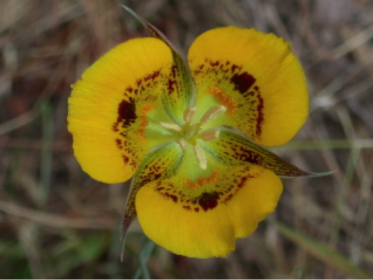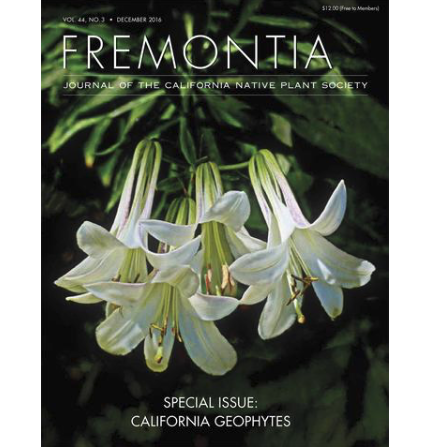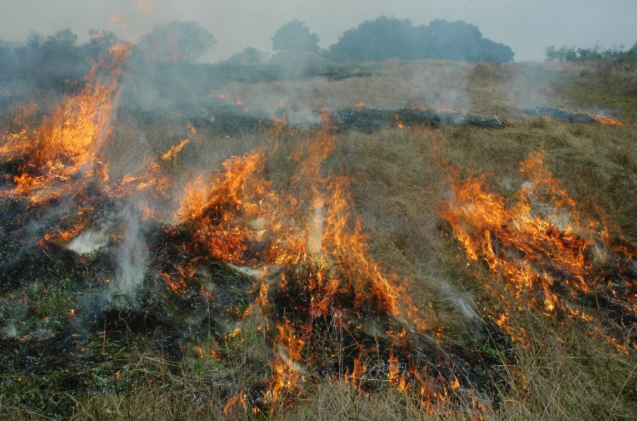December 2017 In the context of the North Bay fires this fall and the ongoing regional discussion about the need for proactively and eco-literately managing our landscapes to be more ‘fire resilient,’ we hope that this case study of OAEC’s 24-year history of coastal prairie restoration efforts might offer some inspiration for a larger vision of Earth – Air – Fire – Water – Bio-Culturally Resilient Landscapes! The full article, published earlier this year, is now available for download on our website.
Mending the Wild at the Occidental Arts & Ecology Center by Brock Dolman, Director of the Wildlands program, was published in Fremontia, Journal of the California Native Plant Society, in a special issue focused on geophytes. What is a geophyte, you may ask?

Broadly speaking, geophytes are flowering plants with underground “storage organs,” known commonly as bulbs, tubers, rhizomes, or corms, designed to allow for survival when aerial parts are exposed to unfavorable conditions such as grazing, drought, fire, frost, etc. In fact, disturbance itself is a key factor in propagation. Bursting into bloom in the spring and then dying back to their underground storage organs during the drought of summer, California native geophytes exhibit a distinctive strategy of adaptation to California’s Mediterranean climate.
This stunning double issue of Fremontia was guest edited by M. Kat Anderson, a long-time friend and collaborator of OAEC, and author of the tome on Traditional Ecological Knowledge called “Tending the Wild,” toward which Brock’s article “Mending the Wild” is a nod. Kat explains in her introduction,
“Population growth and land development after the Gold Rush (…) took its toll on California’s geophytes, as it did for much of the state’s biodiversity. Due to habitat destruction, competition from exotic plants, agricultural plowing, overgrazing by livestock, overharvest of bulbs and flowers for the horticultural trade, and fire suppression, geophyte populations all over the state have diminished. Today, many geophyte species are classified as endangered, threatened, or rare.”
Brock’s article outlines OAEC’s 20-year history of restoration work to regenerate native geophytes found on our site, including yampah (Perideridia spp.), bluedicks (Dichelostema spp.), Triteleia spp., Brodiaea spp., and yellow mariposa lily (Calochortus luteus)
“Using guidelines derived from both indigenous traditional practices and horticultural techniques, (. . .) OAEC designed an active management program through a combination of: collecting native wildflower and grass seeds; reintroducing traditional practices of burning the coastal prairie; active removal of encroaching Douglas fir, coyote brush, Scotch and French brooms; targeted mowing/ weed whipping of invasive annual and perennial grasses; sowing the seeds into the burned and unburned areas; and finally monitoring the results. We call this “mending the wild,” and it requires active human engagement with the landscape repeatedly with an astute focus on managing for stages of succession optimally conducive to the structure, function, and composition of a healthy, diverse coastal prairie.”
For an in-depth account of OAEC’s successful on-site geophyte restoration, read the full article >

A copy of the magazine can be found on the California Native Plant Society website.
Endorsements
“Brock, I enjoyed your article in December’s Fremontia! Your word-smithing makes the subject matter and level of detail all that much more enjoyable! Brock for poet laureate biologist!!” – Harold Appleton, co-author of OAEC’s Wildlands Stewardship Plan
“Dear Brock, I love your article in the latest Fremontia issue on geophytes. I admire your articulate & accessible writing, your long-term commitment, the insightful management & best of all, the successful restoration. Great illustrative photos too. I’ve watched coastal meadows degrade & so many plant communities in dire need of informed management. I too have worked to be a part of the solution over the last 40 years, but your article is inspiring, and that is always welcome! Many thanks, Philip, Cal Flora Nursery”






